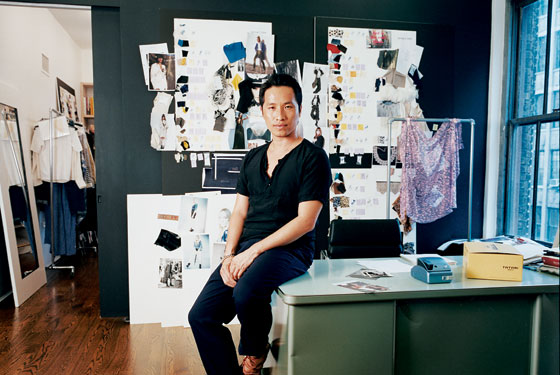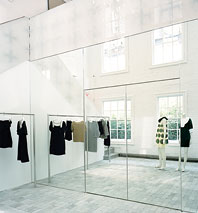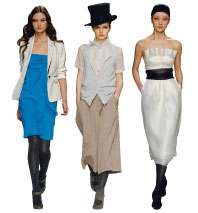
The tidy desk in Phillip Lim’s garment-district office is cluttered, one June morning, with so many dense, fluffy bouquets that he hasn’t even had a chance to unwrap them all. He gestures at a mound of peonies sent over by a major department store. “They’re courting me.” Lim, whose square jaw and underbite give him a look of preternatural determination, seems delighted but restrained. One can presume that another of the arrangements (the identical peonies, perhaps?) is from Barneys, with whom he is, among the New York department stores, going steady.
The previous night, in a humid lobby at the New York Public Library, Lim had been awarded the Swarovski Award for Emerging Talent by the CFDA. In winning, he beat out three massively talented designers, all around his age (33), and stoked the fires of a creative debate that’s at the heart of New York fashion right now. The designers he beat, Thakoon Panichgul and the L.A. sister act of Laura and Kate Mulleavy of Rodarte, work in details and frip: dresses that look not unlike the elaborate petals on Lim’s peonies, for example, or an entire skirt done in oily, iridescent peacock feathers. Both make clothing deeply concerned with the art of fashion: exquisite, to be sure, and very expensive.
It says a lot about the state of fashion that the winning young designer is not someone interested in reinventing the wheel but rather in perfecting it to a smooth, easy, uncomplicated ride.
Lim is not deaf to fashion’s artistic whimsies, but he is acutely aware of commerce. That tidy desk is in a sunny corner of a 10,000-square-foot design floor buzzing with an efficiency rare among designers in the “emerging” division. On a wall there are sketches of Lim’s first freestanding shop, which opened with a crowded party early last week: It’s an airy duplex in a fancy part of town, with double-height windows and groovy design.
Fed by a stream of celebrity tabloid culture, fashion television, and Websites, people are madder for fashion at the moment than they’ve ever been, and yet so much fashion is so far out of reach; blame it on the mighty euro, blame it on the brutal economics of small-scale production, but clothes have never cost more. Inexpensive chains led by that Swedish hothouse H&M address the craving with quick knockoffs, but the quality is often lacking, and the clothes too faddish to have much of a shelf life.
Enter Phillip Lim. He’s not a big talker, like other designers can be, about certain movies or style icons or villages in the south of France. He doesn’t wave his hands around or make campy jokes or reference obscure pop bands. When he offers descriptions of what he does, he is blunt and direct. “Classic but twisted,” he’ll say, which is somewhat clichéd fashion-speak for the updating (usually the trimming down) of classic patterns. Lim has been in business only since 2005, but his collection is already in 300 stores. Last season, he did $12 million wholesale—and that was without licenses for sunglasses or perfume or extra-low-price shoes (although he has recently done collaborations with Birkenstock licensee Tatami and the Japanese retailer Uniqlo).
Because here’s what Lim and his business partner, Wen Zhou (more on her below), have figured out: Women want very much to buy capital-F fashion, but they’d like to be able to afford it and, once in it, they’d rather not look absurd, as can happen when shapes expand (volume!) and contract (minis!). The Lim look is simple and directional enough to count as a designer (it often hangs alongside Miu Miu and See by Chloé), but not so complicated that it’s challenging to wear—like a distressed Marc Jacobs cocoon or a narrow, shiny Proenza Schouler corset. In any given Lim collection, there are peacoats, simple silk blouses, and very few patterns. The clothes are not exactly minimalist, but they are not exuberant, either. When they are embellished, it’s tame: a small bow, a slight ruffle, uniform embroidery. And mostly, the price is right: Dresses hover in the $300 to $600 range. This spring, a T-shirt dress covered in appliqué roses came in black and white and cost $495. It sold out almost immediately. Coach creative director Reed Krakoff, who knows quite a bit about mass appeal, says, “Phillip’s clothes are very easy to understand. It sounds logical, but things don’t always come together so well.” Simplicity, it turns out, is not that easy.

“He’s my top seller, No. 1, absolutely,” says Jen Mankins, who owns Brooklyn’s two Bird boutiques. “It’s easy, not fussy, and”—here Mankins looks awestruck—“it’s designer quality at a contemporary price. My customers go crazy.”
Lim was born in Thailand to Chinese parents. When he was a baby, his parents went briefly to Cambodia, then fled the civil war. “You know The Killing Fields?” Lim says with his typical bluntness one afternoon over Diet Cokes at the Mercer Hotel. “That was our life.” The Lims wound up in Southern California, where his mother worked as a seamstress and his father as a professional poker player. “I think,” Lim says intensely, “I actually learned more from my father.” Shrewd risk-taking has served Lim every bit as much, if not more, than cutting and sewing, as has a sense of style cultivated from youth. “I would direct my mother when she made my clothes,” he says. He liked khakis and denim work shirts, everything simple and clean. “I look at pictures of myself when I was 5 years old and I think that, yes, that is exactly what I like.”
While studying home economics at UC Long Beach and working at Barneys in Orange County, Lim unpacked a box of clothing by the cool, cultish Katayone Adeli and thought, “This I understand.” Lim called and asked for an internship. “They said, ‘Great, bring a portfolio’, and I said, ‘What is that?’ ” But he talked his way into the job and moved into the position of design assistant.
When Adeli moved her business to New York, Lim decided to stay in California. A friend of a friend was in the surfwear business and heard that Lim was unemployed. “He basically said, ‘I’ll back you,’ and I said, ‘Great, but I don’t know what I’m doing,’ and he said, ‘Well, let’s try.’ ” That was in the fall of 2000, and the result was Development: a collection of simple clothes for girls in their twenties—basic colors, easy shapes.
Development was successful, but it was small, and in 2005, Lim’s bosses decided they were interested in the poppy sportswear trend that was defining California style: Juicy Couture, C&C California.
Lim was not.
Lim was bereft.
Enter Wen Zhou.
Wen Zhou can make you feel, in the course of a conversation, instantly lazy. She is small and unmade-up: She wears her hair in a ponytail; she looks more like an undergraduate than the massively successful garmento that she is.
Zhou’s background is similar to Lim’s: Chinese immigrant parents—her mother is a seamstress, her father was a dishwasher. She and Lim often say of one another, “We’re the same people, but one wears a skirt.” Zhou started in fashion selling buttons as a summer job; by the time she was 21, she was CEO of a fabric company, and Development was one of her clients.
“I saw Phillip’s stuff, and I just knew that it was good,” Zhou says. Like Lim, she resists the drippy descriptives of fashion-talk. Pressed, she says only, “I just knew.” When Lim lost his job at Development, Zhou sent him a plane ticket to New York. He arrived on a Thursday. She allowed him one day of misery. “By Friday she said, ‘Okay. That’s enough. I’m tired of you crying,’ ” Lim says. “ ‘Let’s start a company.’ ” On Monday, she put up $750,000 from her fabric business for Lim to get started. She gave him a room in her apartment, told him to have a collection ready in two months, and that he’d best think up a name, stat. Since they were both 31 at the time, and since being successful at a young age was so defining, the label became 3.1 phillip lim.

“My accountant said, ‘You’re crazy,’ ” Zhou says. “In the first six months, we did $2.8 million in sales.” She shrugs. “So we made it back.”
And then some: The fall 2007 season did $12 million in sales. “Crazy, right?” she says, and laughs.
Lim and Zhou have managed to keep their costs down through discipline. “No excess,” says Zhou, and you believe her. Lim has only the smallest design department—three employees—and they work mostly on logistics. Much of the production is in China, and the duo’s ability to communicate in Chinese is infinitely helpful. “It’s more than just language,” Zhou says, “it’s a cultural thing. I don’t know how it works if you’re not Chinese.” And, of course, Zhou supplies much of the fabric.
At Lim’s opening party, the air-conditioner wasn’t working, and his guests were flushed and sweaty. The most comfortable were the girls in the Phillip Lim dresses that seemed perfectly suited to the weather, yes, and to the party, but also to the moment happening outside the tall glass doors and across Prince Street, and to the East, and the West. It’s a new kind of brand for New York—one it turns out we really, really wanted.